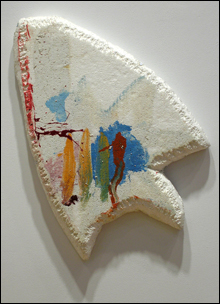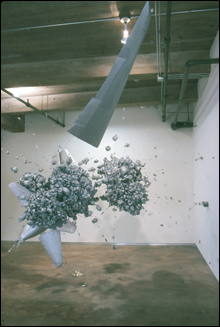Ugly beautyThe RISD Museum showcases ‘Stryrofoam’ March 25,
2008 3:38:26 PM

‘ONE OF THE WORST MATERIALS USED BY
MAN: ’Tuttle’s Lonesome Cowboy Styrofoam
#7.
|
There is something about foamed polystyrene — better known by its trademark name, Styrofoam — that seems to embody the space-age future. This, and the fact that it’s light, cheap, and easily worked draws some artists to use it. But for many artists, the attraction to Styrofoam is that it is crap — usually nonbiodegradable, difficult to recycle, and ugly.
“It’s not to celebrate this material that I used it,” Richard Tuttle has written. “It is one of the worst materials used by man.”
It’s the crap aspect of the material that rises to the surface of the RISD Museum’s “Styrofoam,” a small, smartly organized show of irritating art. Judith Tannen¬baum, the museum’s contemporary art curator, has rounded up a number of artists who use Styrofoam and, in doing so, corrals a trend burbling up in art today that begins with the material and runs toward an idea. But most of the art here is offputting — and purposely so.
A couple of the more handsome pieces are Sol LeWitt’s 1993 Black Styrofoam on White Wall and White Styrofoam on Black Wall. Following the late conceptual artist’s simple instructions, museum installers randomly break up sheets of Styrofoam and piece the shards together on the gallery wall. It looks like the stonework walls in dens of mid-century modern bungalows. LeWitt, Tannen¬baum reports, later quit using Styrofoam, concerned that it hurt the environment.
Folkert de Jong’s 2007 The Piper is a polystyrene foam and liquid plastic sculpture of a lurching green-faced zombie Abraham Lincoln, wearing a kilt and playing a bagpipe. It feels patched together like a dollar store Frankenstein’s monster. Lincoln’s neck bends to the side and out burbles a mess of green goop. This Lincoln comes from de Jong’s sculptural group, Death March: My Blood, My Oil and My Ass. It’s an allegory of American consumerist thirst that leads us to war and rots us from the inside.

A PRE-9/11 DARK CHARGE: Fasnacht’s
Exploding Airplane
.
|
That burbling neck stuff seems to be polyurethane foam, which can be sprayed or poured and then mushrooms to several times its original volume. It has become a favorite material for artists today, especially those making what art blogger Tyler Green has called “scattertrash” and what New York’s New Museum, in a current exhibit, dubbed “Unmonumental.” This sculpture — which isn’t much represented here —— often features seemingly random assemblages made from repurposed industrial materials and junk, often with the parts retaining their original identities.
I’ve called it “flarf sculpture,” after a style of goofy non sequitur avant-garde poetry that has developed in the past decade or so. Favoring typos and other ways of being “wrong,” flarf poetry is often built from collaged Google search results and Internet chat room texts. The technique is sometimes called “Google sculpting.”
The patron saint of this sort of art is Tuttle who, like several of the artists here, focuses his artistic practice on everyday materials. And what is more everyday American than Styrofoam? He’s represented by a book and a pair of 1988 painted styrofoam panels. One looks like a giant arrow head; the other resembles a chipped shield. The edges of the beady styrofoam are rough and chipped, and tiny Styrofoam pebbles got stuck in the paint, which appears defiantly slapdash.
Other works here are more clean and minimalist, including a hollow cylindrical stack of blue foam bricks, an arrangement of pink Styrofoam cinderblocks, and photos of Styrofoam forms shot close-up so they resemble ancient architecture.
Tom Friedman sculpted a Styrofoam bee that bobs on a wire sticking out of a frosty blue Styrofoam block. It’s neat-o and cute, but blue Styrofoam dust sprinkled on the floor around the block looks toxic.
Heide Fasnacht’s 2000 Exploding Airplane, hung about 12 feet up in the air in a corner of the gallery, is an airliner made from silver-painted Styrofoam and urethane foam. The fuselage bursts in half, as if a bomb exploded inside. Wings spin off. Foam blobs, like clouds from the explosion, bubble out from the plane on wires and rods. Made before September 11, the terrorist attacks give the piece a whole new dark charge.
But no matter the ostensible subject, Styrofoam seems to embody artists’ love/hate relationship with America’s ugly industrial toxic synthetic mass-produced junk culture. Styrofoam, de Jong has said, “reflects mass consumption, and market economy in the extreme.” Styrofoam is America distilled.
“Styrofoam” | RISD Museum, 224 Benefit Street, Providence | Through July 20
|
 |

|
- How Herald publisher Pat Purcell could pitch inside — and brush back the Globe
- Reconciling the irreconcilable
- The wars of evolution are louder than ever. What Ben Stein, Bad Religion, and a physics professor from Quincy can tell you about where you came from.
- Win or lose, Obama's small donors may have already brought a revolution in campaign financing
- Israeli magic realism
- Some Things at Trinity
- How Herald publisher Pat Purcell could pitch inside — and brush back the Globe
- Nancy Goldner on Mr. B
- Swan Lake in Boston and Providence
- Dolly Parton rolls out the big guns
- Keep your hands on the pole and not on your neighbor’s ass, bucko.
- The wars of evolution are louder than ever. What Ben Stein, Bad Religion, and a physics professor from Quincy can tell you about where you came from.
|
-
The high voltage work of Corita Kent
-
Walid Raad’s installations seek the “truth”
-
Compelling new work by Neal T. Walsh and William Schaff
-
Malcolm Grear at RIC; plus, Roger Mayer’s ‘Soundless’
-
A local collective subverts with the tiny
-
Shake-ups on the gallery scene
-
Art on the move
-
‘Street Level’ at the ICA, plus Ranjani Shettar and David Claerbout
-
New exhits at the Stairwell, Bannister, and URI galleries
|

- The peculiar American brashness of George Bellows
- Walid Raad’s installations seek the “truth”
- The DeCordova Annual, New Orleans after Katrina, ‘Superartificial,’ 19th-Century Leisure Travel, and El Chango Verde
- ‘Alexis Rockman,’ ‘The New Authentics,’ and ‘Paper Trail II’ at the Rose, and Chantal Akerman at MIT
- Compelling new work by Neal T. Walsh and William Schaff
- ‘El Greco to Velázquez’ at the MFA
- ‘Wedded Bliss’ at the Peabody Essex, Toys and Games at the Revolving Museum, and Chad Walker at Space 242
- The mature art of longtime Maine artists
- Malcolm Grear at RIC; plus, Roger Mayer’s ‘Soundless’
- A local collective subverts with the tiny
|
|